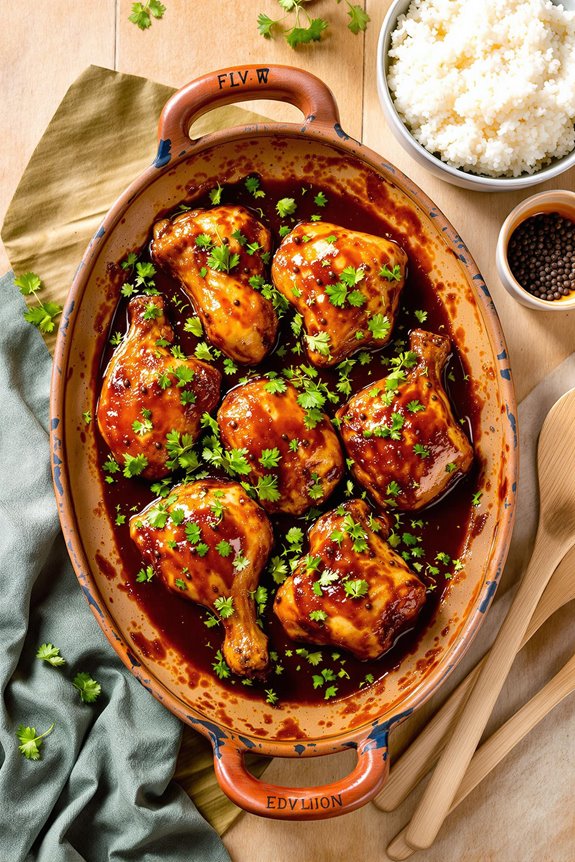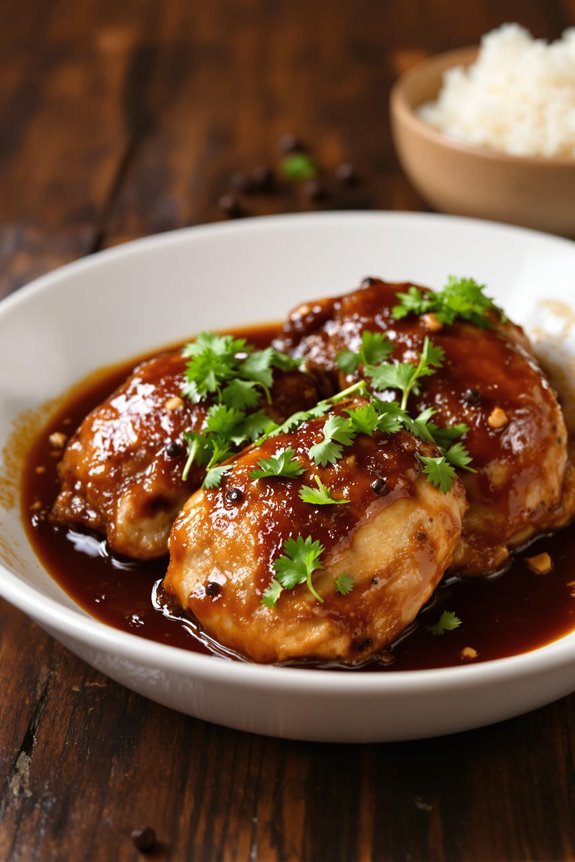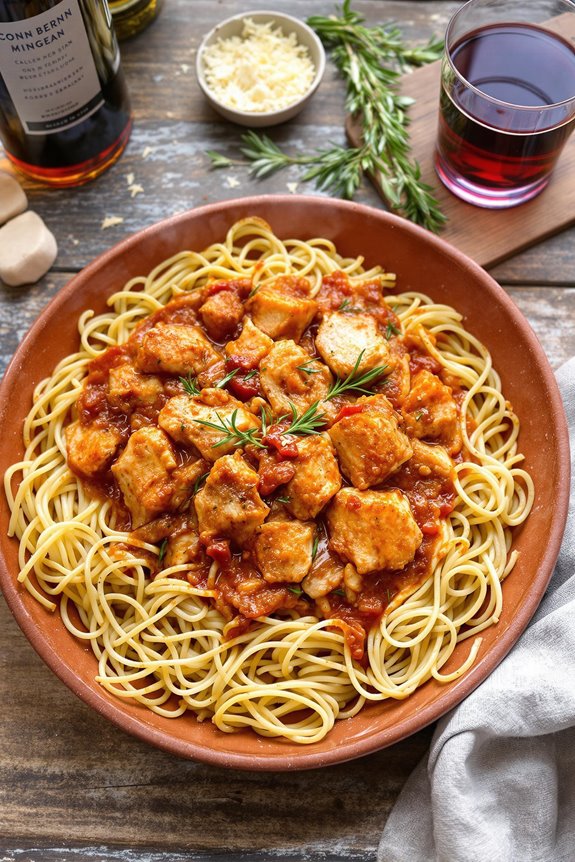Links below are affiliate links. We earn a commission on purchases at no extra cost to you.
Savory Filipino Chicken Adobo Recipe
Savor the irresistible blend of tangy vinegar and soy sauce in authentic Filipino chicken adobo that will transport your taste buds to Manila.

Why You’ll Love this Filipino Chicken Adobo
If you’ve never experienced the tangy, savory glory of Filipino Chicken Adobo, you’re in for a life-changing culinary adventure.
The magic happens when vinegar, soy sauce, and garlic create that perfect balance of sour, salty, and umami flavors that simply dance on your tongue.
I’m particularly fond of how the chicken becomes fall-off-the-bone tender while developing that beautiful caramelized exterior during the final browning step.
What I adore most is how this dish actually improves with time—tomorrow’s leftovers might taste even better than tonight’s dinner, if you can resist devouring it all immediately!
What Ingredients are in Filipino Chicken Adobo?
Filipino Chicken Adobo is all about simple, powerful ingredients coming together to create something truly magical. The beauty of this dish lies in how just a handful of pantry staples transform ordinary chicken into something extraordinary.
What makes adobo special is the perfect balance between tangy vinegar and savory soy sauce, creating that distinctive flavor profile that’s become the unofficial national dish of the Philippines. Ready to gather what you need for this delicious journey?
- 6 chicken legs, cut into drumstick and thigh pieces
- 1 cup white vinegar
- 1/2 cup reduced sodium soy sauce
- 2 garlic cloves, pressed
- 1 bay leaf
- 1 1/2 teaspoons peppercorns, lightly crushed
- 1 cup water
- 3 tablespoons canola oil
- 4 tablespoons cilantro, chopped (for garnish)
While the ingredient list is relatively short, each component plays a vital role in building the authentic flavor. I recommend using a good quality white vinegar rather than substituting with other varieties to maintain that classic taste.
The reduced-sodium soy sauce gives you better control over the saltiness of the final dish. And don’t skip those peppercorns—crushing them releases more flavor than using pre-ground pepper.
If you can’t find whole chicken legs, thighs work wonderfully on their own, staying juicy and tender throughout the cooking process. And remember, while cilantro makes a beautiful garnish, it’s optional if you’re dealing with cilantro-averse dinner guests.
How to Make this Filipino Chicken Adobo

Making chicken adobo starts with creating that signature tangy marinade. In a large glass baking dish, combine 1 cup white vinegar, 2 pressed garlic cloves, 1 bay leaf, 1½ teaspoons of lightly crushed peppercorns, and ½ cup reduced sodium soy sauce. This flavor-packed mixture becomes the foundation of our dish.
Add 6 chicken legs (cut into drumsticks and thighs) and toss until every piece is thoroughly coated. Cover the dish and let it marinate in the refrigerator for an hour—this waiting time is when the magic happens, as the meat absorbs all those wonderful flavors.
When you’re ready to cook, transfer the chicken and all that marinade to a large saucepan, add 1 cup of water, and bring everything to a boil. This is where patience pays off. Cover the pan, reduce the heat to low, and let it simmer for about 20 minutes. The kitchen will fill with the most incredible aroma—vinegary, garlicky, with hints of bay and black pepper.
Once the chicken has cooked through, remove it with tongs and set aside. Now, we concentrate the sauce by boiling it for another 10 minutes until it reduces to about 1 cup. Let this liquid cool, then strain it into a small saucepan to remove the peppercorns and bay leaf. Skim off any fat that rises to the top and reheat the sauce.
For that perfect finishing touch, pat the chicken pieces dry with paper towels—this important step guarantees they’ll brown beautifully. Heat 3 tablespoons of canola oil in a large skillet until it’s nice and hot, then brown the chicken in batches, about 2 minutes per side. You want that slightly crispy exterior that contrasts with the tender meat inside.
Having essential Filipino appliances in your kitchen can make authentic dishes like adobo much easier to prepare with consistent results.
Transfer your browned chicken to a deep platter, pour the hot sauce over it, and if you’re feeling fancy, garnish with 4 tablespoons of chopped cilantro. The result? A perfectly balanced dish with tender chicken swimming in a savory-tangy sauce that’s absolutely worth the effort.
Filipino Chicken Adobo Substitutions and Variations
While traditional chicken adobo follows a time-honored recipe, there’s plenty of room for customization based on your pantry ingredients or flavor preferences.
I love how versatile this Filipino classic can be!
Try swapping chicken legs for thighs or even a whole chicken cut into pieces.
Don’t have white vinegar? Rice vinegar or apple cider vinegar work beautifully, though each brings its own subtle character to the dish.
You can also add coconut milk for a creamier sauce, or toss in some potatoes during simmering for a heartier meal.
The garlic quantity? Well, I believe that’s always negotiable—more is rarely wrong!
What to Serve with Filipino Chicken Adobo
The perfect accompaniment to chicken adobo‘s rich, tangy sauce is, without question, a generous mound of steaming white rice. I can’t imagine enjoying those savory juices without rice to soak up every last drop!
For a complete Filipino meal, I’d also recommend adding a side of simply sautéed bok choy or kangkong (water spinach) with garlic.
An invigorating cucumber-tomato salad with a splash of rice vinegar offers the perfect counterpoint to the dish’s intensity. And don’t forget to pour yourself a cold glass of calamansi juice—its bright citrus notes will cleanse your palate between those deliciously complex bites.
Final Thoughts
As I reach the end of this culinary journey with Filipino Chicken Adobo, I’m struck by how this dish exemplifies the beauty of simplicity in cooking.
The magic of adobo lies in its perfect balance—tangy vinegar, savory soy sauce, and aromatic spices creating a symphony of flavors that transform humble chicken into something extraordinary.
It’s the kind of recipe that doesn’t demand perfection; the sauce forgives minor measurement variations, which is quite comforting for those of us who occasionally “eyeball” ingredients.
What I love most is how this dish connects us to Filipino culinary traditions while fitting seamlessly into our modern kitchens.






